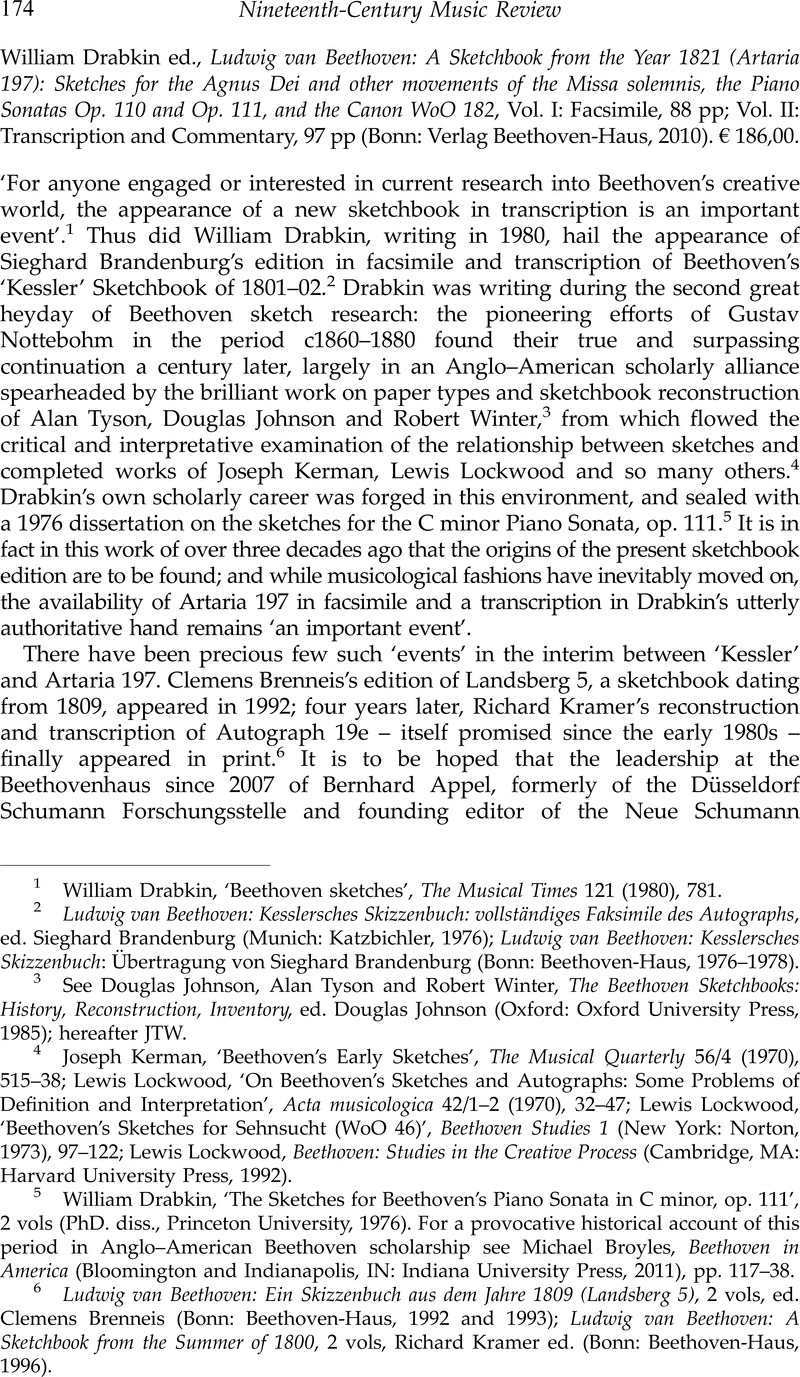No CrossRef data available.
Published online by Cambridge University Press: 17 June 2013

1 Drabkin, William, ‘Beethoven sketches’, The Musical Times 121 (1980), 781Google Scholar
2 Ludwig van Beethoven: Kesslersches Skizzenbuch: vollständiges Faksimile des Autographs, ed. Sieghard Brandenburg (Munich: Katzbichler, 1976); Ludwig van Beethoven: Kesslersches Skizzenbuch: Übertragung von Sieghard Brandenburg (Bonn: Beethoven-Haus, 1976–1978).
3 Douglas Johnson, Alan Tyson and Robert Winter, The Beethoven Sketchbooks: History, Reconstruction, Inventory, ed. Douglas Johnson (Oxford: Oxford University Press, 1985)Google Scholar
4 Kerman, Joseph, ‘Beethoven's Early Sketches’, The Musical Quarterly 56/4 (1970), 515–538Google Scholar
Lockwood, Lewis, ‘On Beethoven's Sketches and Autographs: Some Problems of Definition and Interpretation’, Acta musicologica 42/1–2 (1970), 32–47Google Scholar
Lewis Lockwood, ‘Beethoven's Sketches for Sehnsucht (WoO 46)’, Beethoven Studies 1 (New York: Norton, 1973)Google Scholar
Lockwood, Lewis, Beethoven: Studies in the Creative Process (Cambridge, MA: Harvard University Press, 1992)CrossRefGoogle Scholar
5 Drabkin, William, ‘The Sketches for Beethoven's Piano Sonata in C minor, op. 111’, 2 vols (PhD. diss., Princeton University, 1976)Google Scholar
Broyles, Michael, Beethoven in America (Bloomington and Indianapolis, IN: Indiana University Press, 2011)Google Scholar
6 Ludwig van Beethoven: Ein Skizzenbuch aus dem Jahre 1809 (Landsberg 5), 2 vols, ed. Clemens Brenneis (Bonn: Beethoven-Haus, 1992 and 1993); Ludwig van Beethoven: A Sketchbook from the Summer of 1800, 2 vols, Richard Kramer ed. (Bonn: Beethoven-Haus, 1996).
7 Artaria 195: Beethoven's Sketchbook for the “Missa solemnis” and the Piano Sonata in E major, opus 109, transcribed, edited and with a commentary by William Kinderman, 3 vols. (Urbana and Chicago, IL: University of Illinois Press, 2003).
8 JTW, pp. 271–2. The identification of a hitherto unremarked setting of the plainsong hymn Pange lingua gloriosa on page 4, staves 1/2-3/4 was made by Barry Cooper during 2012 (see, for example, http://www.bbc.co.uk/news/entertainment-arts-20070588), after this review had been submitted for publication.
9 Among his other publications on the Missa cited in the endnotes to the Introduction and Commentary (II, 30–3), Drabkin omits to cite his Beethoven: Missa solemnis (Cambridge: Cambridge University Press, 1991), which surveys the sources for the work.
10 Drabkin, ‘Beethoven Sketches’: 782Google Scholar
11 Drabkin's identification, in his ‘Inventory of the Sketchbook’ (II, 20) of this sketch as ‘End of a piece in B or B flat’ is entirely plausible; but Beethoven provides no characteristic final barline marking a real ending (compare I, 77, st. 6/7), and there is nothing to say that these two bars do not represent a half-cadence in E or E flat. This is not to say, however, that the sketch on I, 1, st. 1/2 corresponds directly to any part of the second movement of op. 109.
12 Drabkin, ‘Beethoven Sketches’: 782Google Scholar